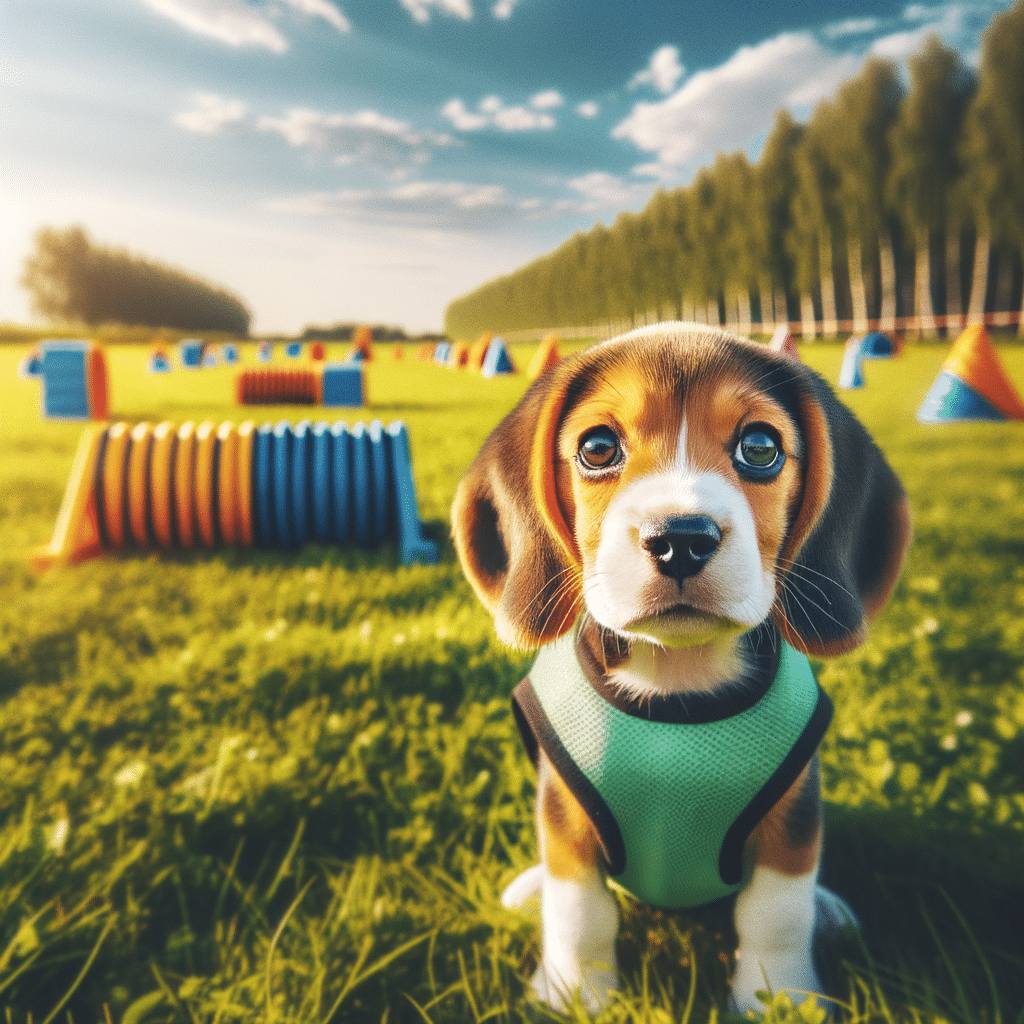Training beagles presents unique challenges owing to their distinct personality traits and breed characteristics. Although they are noted for their intelligence and capable of learning various commands and behaviors, beagles are often considered challenging to train.
In This Article
Their curious nature and powerful sense of smell can lead to frequent distractions, complicating training sessions. Understanding the beagle’s temperament is key in the training process. You must balance their eagerness to please and their stubborn streak.
Effective training strategies for beagles involve consistency, patience, and positive reinforcement techniques. These strategies accommodate the beagle’s desire for exploration and mental stimulation. Practical exercises tailored to work with the beagle’s instincts can greatly aid the training process.
In addition, beginning training at a young age, offering ample socialization opportunities, and maintaining a structured routine are strongly recommended to help control the breed’s easily distracted nature. By addressing these key elements, beagle owners can work towards overcoming the breed’s training difficulties.
Highlights
- Beagles are intelligent but can be challenging to train due to their distractible nature.
- Understanding a beagle’s temperament is essential for successful training.
- Consistent, positive reinforcement methods are most effective for training beagles.
Understanding the Beagle Temperament
When training a Beagle, you should appreciate their unique blend of traits, notably their high energy and independent nature, which can both aid and challenge the training process. Recognizing these characteristics gives insight into the tailored approaches needed for effective beagle training.
Inherent Traits
Beagles are a breed with a strong sense of smell and an independent streak, qualities originating from their use as hunting dogs. Primarily, they are scent hounds, known to have over 220 million scent receptors. This special ability can sometimes lead to stubbornness if they focus on a scent and not the trainer’s commands.
Beagle Behavior Patterns
Behaviorally, beagles are curious and loving dogs. They tend to be very energetic, requiring consistent mental and physical exercise to prevent destructive behavior. A beagle’s curiosity can lead them to roam and explore beyond safe spaces without adequate stimulation.
Comparing Beagles to Other Breeds
Compared to breeds like the border collie, known for its trainability, beagles may respond slowly due to their independent nature. While beagles possess intelligence, their propensity to follow their nose rather than commands can take training longer.
Age-Related Training Considerations
The age of a beagle affects its trainability. A beagle puppy may learn quickly but also get easily distracted. Senior dogs may be less distractible and have some ingrained habits but can still be trained with regular training sessions. Consistency is vital across all ages to combat their instinct to explore with independence.
Exercise and Stimulation Needs
Exercise is crucial for beagles due to their high energy levels. Daily walks and playtime help to manage excess energy, allowing them to focus their attention. Additionally, mental stimulation is required to engage their intelligent and curious nature, aiding the training process.
Managing the Beagle’s Independence
The beagle’s independent nature can be challenging but also rewarding to work with. Encouraging behaviors that leverage the beagle’s ability to explore and engage with their environment within a safe space can be beneficial. Maintaining consistent discipline and support can help beagles channel their independent traits productively during training.
Effective Training Strategies for Beagles
Training a beagle requires understanding its unique traits, such as its strong sense of smell and desire for exploration. Employing the right strategies can make the process smoother and more enjoyable for both the dog and the owner.
Foundation Training Techniques
Foundation training for beagles should focus on basic commands such as “Sit,” “Stay,” and “Come.” These commands form the cornerstone of good behavior and should be initiated during the puppy stage, ideally between eight and twelve weeks old.
Overcoming Beagle Training Challenges
Beagles are easily distracted by scents and may be stubborn, presenting certain challenges. Overcome these by training in a quiet environment and using a clicker for immediate positive reinforcement, building focus and trust.
Obedience and Command Training
Obedience training involves teaching beagles to respond to commands like “recall,” which is pivotal for their safety. Consistent practice and positive reinforcement are key, with each command introduced sequentially to avoid overwhelming the dog.
Utilizing Treats and Rewards Effectively
Use moderate rewards such as treats, praise, and toys to motivate beagles. Establish a clear link between the command and the reward to ensure the beagle understands which actions bring rewards.
Consistency and Routine in Training
Consistency in commands, tone, and rewards helps beagles understand expectations. A routine reinforces training, with scheduled sessions contributing to better adherence and progress.
Professional Training and When to Consider It
Consulting professional dog training services may be beneficial if owners face persistent challenges. They can provide tailored strategies, especially for more advanced training such as crate training or addressing behavioral issues like excessive barking.
Importance of Socializing and Exposure
Early socializing is essential for beagles. Exposing them to various people, dogs, and environments can reduce anxiety and improve behavioral adaptability, making them more receptive to training in the long term.
Practical Training Tips and Exercises
Training a beagle requires patience and consistency. This section provides practical advice to ensure that training is effective and adapted to a beagle’s unique disposition, emphasizing the importance of consistent reinforcement and clear communication.
Leash and Collar Acclimation
Before engaging in more advanced training, it’s essential to introduce a beagle to its leash and collar or harness. Begin by allowing the dog to wear the collar during playtime for short periods to associate it with positive experiences. Gradually increase the duration and introduce the leash, letting the dog drag it around without holding it, then taking hold and practicing walking in a safe, enclosed space.
Mastering Recall and Off-Leash Skills
A reliable recall command is crucial, especially for scent-driven beagles. Start in a distraction-free environment using a long leash. Use a consistent verbal command like “Come” and reward them when they obey.
Gradually introduce more distractions and practice in various settings to strengthen their recall ability as their response improves. Eventually, with built trust, one can transition to off-leash exercises in safe, enclosed areas.
Interactive Play and Learning Games
Beagles possess high energy levels, which can be channeled through interactive play. Games such as fetch or finding hidden treats can keep training sessions lively and foster a beagle’s problem-solving skills. Incorporating play into learning expends energy and keeps them focused on tasks and commands.
Setting Up a Conducive Training Environment
Create a safe space for training where distractions are minimized. This could be a quiet room or a fenced yard with puppy pads in a designated area for house training. The training area should include various toys and rewards to engage the beagle, along with tools like a crate for crate training and a clicker for clicker training.
Verbal and Non-verbal Communication Cues
Effective communication with a beagle involves both verbal commands and non-verbal signals. Be clear, consistent, and immediate with praise and rewards so the dog understands correct behaviors. For example, the command “Sit” paired with a hand signal can help the beagle understand the desired action faster. Use a calm and assertive tone for commands to establish authority without causing anxiety or fear.
Frequently Asked Questions
This section addresses some common queries regarding beagle training and behavior. Each question provides insightful, specific information based on the experiences of beagle owners and trainers.
What techniques are effective for potty training beagles?
Starting early is crucial. Beagle puppies should begin potty training as soon as their vaccinations are complete. Consistent schedules and positive reinforcement help them learn where and when to relieve themselves. Beginning with indoor puppy pads that gradually shift to outdoors has been known to help the puppy transition from pottying inside the house to outside. Crate training is also encouraged.
What are the challenges of training beagles compared to other breeds?
Beagles can be more challenging to train than other breeds due to their strong sense of smell and independence, leading to distractions and a perceived stubbornness during training sessions.
Are beagles considered suitable for first-time dog owners?
Beagles are friendly and loyal, making them a good choice for first-time owners willing to invest time in consistent, patient training. A new owner should be prepared for the demands of an active and inquisitive dog.
How do beagles typically interact with children?
Beagles are known for their friendly disposition and usually interact well with children. Early socialization and proper training can foster positive relationships between beagles and younger family members.
What are some common issues faced by beagle owners?
Beagle owners often face challenges like the dog’s tendency to follow its nose, leading to wandering or ignoring recall commands. They may also face issues with barking and require strategies to manage vocalizations.






